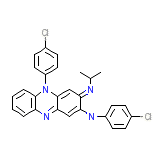Lamprene




Lamprene Brand names, Lamprene Analogs
Lamprene Brand Names Mixture
- No information avaliable
Lamprene Chemical_Formula
C27H22Cl2N4
Lamprene RX_link
http://www.rxlist.com/cgi/generic3/clofazimine.htm
Lamprene fda sheet
Lamprene msds (material safety sheet)
Lamprene Synthesis Reference
No information avaliable
Lamprene Molecular Weight
473.396 g/mol
Lamprene Melting Point
210-212 oC
Lamprene H2O Solubility
0.225 mg/L (virtually insoluble)
Lamprene State
Solid
Lamprene LogP
7.132
Lamprene Dosage Forms
Capsule (50 mg)
Lamprene Indication
For the treatment of lepromatous leprosy, including dapsone-resistant lepromatous leprosy and lepromatous leprosy complicated by erythema nodosum leprosum.
Lamprene Pharmacology
Clofazimine exerts a slow bactericidal effect on Mycobacterium leprae (Hansen's bacillus). Clofazimine inhibits mycobacterial growth and binds preferentially to mycobacterial DNA. Clofazimine also exerts antiinflammatory properties in controlling erythema nodosum leprosum reactions. Clofazimine is highly lipophilic and tends to be deposited predominantly in fatty tissue and in cells of the reticuloendothelial system. It is taken up by macrophages throughout the body. Measurement of the minimum inhibitory concentration (MIC) of clofazimine against leprosy bacilli in vitro is not yet feasible. In the mouse footpad system, the multiplication of M.leprae is inhibited by introducing 0.0001%- 0.001% clofazimine in the diet. Although bacterial killing may begin shortly after starting the drug, it cannot be measured in biopsy tissues taken from patients for mouse footpad studies until approximately 50 days after the start of therapy.
Lamprene Absorption
Absorption varies from 45 to 62% following oral administration in leprosy patients. Bioavailability is approximately 70%. Food increases bioavailability and rate of absorption.
Lamprene side effects and Toxicity
Oral, rabbit: LD50 = 3.3 g/kg; Oral, mouse: LD50 = > 4 g/kg. Severe abdominal symptoms have necessitated exploratory laparotomies in some patients on clofazimine therapy. Rare reports have included splenic infarction, bowel obstruction, and gastrointestinal bleeding. Deaths have been reported, following severe abdominal symptoms.
Lamprene Patient Information
Patients should be warned that Lamprene may cause a discoloration of the skin from red to brownish-black, as well as discoloration of the conjunctivae, lacrimal fluid, sweat, sputum, urine, and feces. Patients should be advised that skin discoloration, although reversible, may take several months or years to disappear after the conclusion of therapy with Lamprene.
Patients should be told to take Lamprene with meals.
Lamprene Organisms Affected
Mycobacteria














